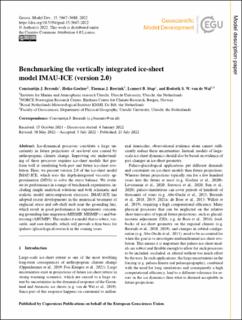| dc.contributor.author | Berends, Constantijn J. | |
| dc.contributor.author | Goelzer, Heiko | |
| dc.contributor.author | Reerink, Thomas J. | |
| dc.contributor.author | Stap, Lennert | |
| dc.contributor.author | van de Wal, Roderik S.W. | |
| dc.date.accessioned | 2022-11-07T12:32:53Z | |
| dc.date.available | 2022-11-07T12:32:53Z | |
| dc.date.created | 2022-08-29T17:17:58Z | |
| dc.date.issued | 2022 | |
| dc.identifier.citation | Geoscientific Model Development. 2022, 15 (14), 5667-5688. | en_US |
| dc.identifier.issn | 1991-959X | |
| dc.identifier.uri | https://hdl.handle.net/11250/3030427 | |
| dc.description.abstract | Ice-dynamical processes constitute a large uncertainty in future projections of sea-level rise caused by anthropogenic climate change. Improving our understanding of these processes requires ice-sheet models that perform well at simulating both past and future ice-sheet evolution. Here, we present version 2.0 of the ice-sheet model IMAU-ICE, which uses the depth-integrated viscosity approximation (DIVA) to solve the stress balance. We evaluate its performance in a range of benchmark experiments, including simple analytical solutions and both schematic and realistic model intercomparison exercises. IMAU-ICE has adopted recent developments in the numerical treatment of englacial stress and sub-shelf melt near the grounding line, which result in good performance in experiments concerning grounding-line migration (MISMIP, MISMIP+) and buttressing (ABUMIP). This makes it a model that is robust, versatile, and user-friendly, which will provide a firm basis for (palaeo-)glaciological research in the coming years. | en_US |
| dc.language.iso | eng | en_US |
| dc.rights | Navngivelse 4.0 Internasjonal | * |
| dc.rights.uri | http://creativecommons.org/licenses/by/4.0/deed.no | * |
| dc.title | Benchmarking the vertically integrated ice-sheet model IMAU-ICE (version 2.0) | en_US |
| dc.title.alternative | Benchmarking the vertically integrated ice-sheet model IMAU-ICE (version 2.0) | en_US |
| dc.type | Peer reviewed | en_US |
| dc.type | Journal article | en_US |
| dc.rights.holder | © Author(s) 2022 | en_US |
| dc.description.version | publishedVersion | en_US |
| cristin.ispublished | true | |
| cristin.fulltext | original | |
| cristin.qualitycode | 2 | |
| dc.identifier.doi | 10.5194/gmd-15-5667-2022 | |
| dc.identifier.cristin | 2046896 | |
| dc.source.journal | Geoscientific Model Development | en_US |
| dc.source.volume | 15 | en_US |
| dc.source.issue | 14 | en_US |
| dc.source.pagenumber | 5667-5688 | en_US |
| dc.relation.project | Norges forskningsråd: 324639 | en_US |
| dc.relation.project | Norges forskningsråd: 295046 | en_US |
| dc.relation.project | Norges forskningsråd: 270061 | en_US |
| dc.relation.project | EC/H2020/869304 | en_US |
| dc.relation.project | Sigma2: NN8006K | en_US |
| dc.relation.project | Sigma2: NS8006K | en_US |
| dc.relation.project | Sigma2: NN9560K | en_US |
| dc.relation.project | Sigma2: NS9560K | en_US |
| dc.relation.project | Sigma2: NS5011K | en_US |

